
Lincoln Motor Company, or simply Lincoln, is the luxury vehicle division of American automobile manufacturer Ford Motor Company. Marketed among the top luxury vehicle brands in the United States, Lincoln is positioned closely against its General Motors counterpart Cadillac. However, beginning with the 2021 model year, they only offer SUV and Crossover vehicles.

Edsel is a discontinued division and brand of automobiles that was produced by the Ford Motor Company in the 1958 to 1960 model years. Deriving its name from Edsel Ford, son of company founder Henry Ford, Edsels were developed in an effort to give Ford a fourth brand to gain additional market share from Chrysler and General Motors. Established as an expansion of the Lincoln–Mercury Division to three brands, re-christened the Mercury–Edsel–Lincoln Division, Edsel shared a price range with Mercury. The division shared its bodies with both Mercury and Ford.

Mercury was a brand of mid-priced automobiles produced by American manufacturer Ford Motor Company between 1938 and 2011 with 1939 being the first model year. It stood as its own line within Ford until 1945, and thereafter formed half of Ford's Lincoln-Mercury Division. The brand was created by Edsel Ford in 1938 to bridge the gap between the Ford and Lincoln model lines.
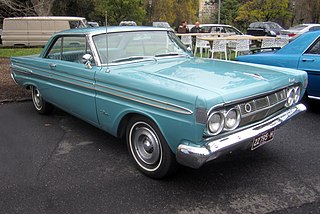
The Mercury Comet is an automobile that was produced by Mercury from 1960–1969 and 1971–1977 — variously as either a compact or an intermediate car. In its first two years, it was marketed as the "Comet" and from 1962 as the "Mercury Comet".
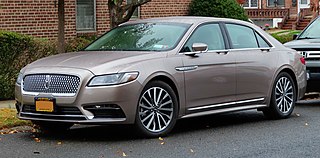
The Lincoln Continental is a series of mid-sized and full-sized luxury cars produced between 1939 and 2020 by Lincoln, a division of the American automaker Ford Motor Company. The model line was introduced following the construction of a personal vehicle for Edsel Ford, who commissioned a coachbuilt 1939 Lincoln-Zephyr convertible, developed as a vacation vehicle to attract potential Lincoln buyers. In what would give the model line its name, the exterior was given European "continental" styling elements, including a rear-mounted spare tire.

The Mercury Monarch is a compact automobile that was marketed by the Mercury division of Ford from the 1975 to 1980 model years. Designed as the original successor for the Mercury Comet, the Monarch was marketed as a luxury compact vehicle; alongside its Ford Granada counterpart, the Monarch expanded the segment in the United States as automakers responded to the 1973 fuel crisis.

The tailfin era of automobile styling encompassed the 1950s and 1960s, peaking between 1955 and 1961. It was a style that spread worldwide, as car designers picked up styling trends from the US automobile industry, where it was regarded as the "golden age" of American auto design and American exceptionalism.

Meteor was a marque of automobiles offered by Ford Motor Company of Canada from 1949 to 1976. The make was retired for the 1962 and 1963 model years, when the name was used for the Mercury Meteor sold in the United States. It succeeded the Mercury 114, a Canadian-market Mercury based on the Ford, the "114" name being taken from the car's wheelbase.

The Mercury Park Lane is a full-sized automobile that was produced by the Mercury division of Ford Motor Company. While not officially introduced as the replacement of the Mercury Turnpike Cruiser, the Park Lane became the flagship of the Mercury model line upon its introduction. The second-generation Park Lane was positioned above the Mercury Montclair.

The Mercury Colony Park is an American luxury full-size station wagon that was marketed by the Mercury division of Ford Motor Company between 1957 and 1991. Distinguished by its simulated wood-grain paneling, the Colony Park was marketed as either the premium-trim or the sole full-size station wagon offering of the division. Following the 1960 demise of Edsel, full-size Mercury vehicles shared bodywork with Ford; the Colony Park served as the counterpart of the Ford Country Squire through 1991.
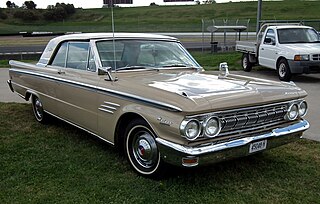
The Mercury Meteor is an automobile that was produced by Mercury from the 1961 to 1963 model years. Adopting its nameplate from the namesake Ford of Canada brand, the Meteor was introduced as the base-trim full-size Mercury sedan, while the compact Mercury Comet shared a naming convention associated with the ongoing Space Race of the early 1960s. Slotted below the Mercury Monterey, the Meteor was the Mercury counterpart of the Ford Fairlane.
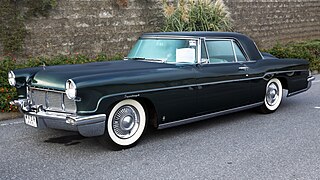
The Continental Mark series is a series of personal luxury cars that was produced by Ford Motor Company. The nomenclature came into use with the Continental Mark II for 1956, which was a successor to the Lincoln Continental of 1939–1948. Following the discontinuation of the Mark II, Ford continued the use of the Mark series on Continental-branded vehicles from 1958 to 1960.

The Edsel Corsair is an automobile that was produced and sold by Edsel in 1958 and 1959. For 1958, the Corsair was built on the longer, wider Edsel platform shared with Mercury. For 1959, the Corsair shared the shorter, narrower Ranger platform with Ford.
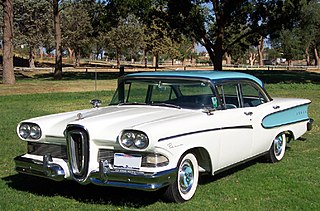
The Edsel Pacer is an automobile that was produced and sold by Edsel in 1958. The Pacer was based on the shorter narrower Edsel platform, shared with Ford and the Ranger.

The Edsel Ranger is an automobile that was produced and sold by the newly formed Edsel Division of Ford for the 1958–1960 model years. It was built on the shorter, narrower Edsel platform, shared with Ford and Edsel Pacer models.

The Edsel Villager is a station wagon that was produced and sold by Edsel from 1958 to 1960. Introduced using the narrower Ford station wagon body, the Villager was a divisional counterpart of the Ford Country Sedan. As the Edsel Ranger was derived from the Ford Fairlane, the Villager shared much of its body stampings with the Country Sedan wagon.

The Ford Falcon is a model line of cars that was produced by Ford from the 1960 to 1970 model years. Though preceded by the Rambler American, the Falcon was the first compact car marketed by the Big Three American manufacturers.

The Mercury Monterey is a series of full-size cars that were manufactured and marketed by the Mercury division of Ford from 1950 to 1974. Deriving its name from Monterey Bay, the initial Mercury Monterey served as the top-of-the-line two-door sedan model for 1950 and 1951 to compete with the hardtop models of Oldsmobile and Buick. It came with a vinyl roof covering, upgraded upholstery, and other features. The hardtop was introduced for 1952. During its production, the Monterey would be offered in multiple body styles, ranging from coupes, convertibles, sedans, hardtops, and station wagons.
Full-size Ford is a term adopted for a long-running line of Ford vehicles with a shared model lineage in North America. Originating in 1908 with the Ford Model T, the line ended in 2019 with the Ford Taurus, as Ford withdrew from the full-sized sedan segment in North America. Across 111 years, 15 generations, and over 60 million examples of the model line were produced across over 50 model nameplates. By contrast, the longest-running single nameplate worldwide is the Chevrolet Suburban, in use since the 1935 model year.

Monarch was an automobile marque produced by Ford Canada from 1946 through 1957 and from 1959 to 1961. The Monarch was marketed as its own brand of car rather than as a Ford, with its own model names which included Richelieu, Lucerne and Sceptre.




















